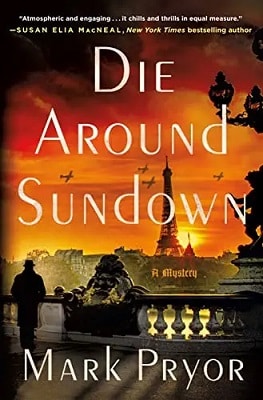Die Around Sundown
An atmospheric police procedural that catapults into a historical fiction mystery with clues chased down in the shadowy streets of Paris filled with jackbooted Nazi bastards.
Meet Inspector Henri LeFort a righteous and highly scrupled cop with a dogged determination to wade through the morass of clues in spite of Nazi roadblocks and obstacles in his investigation to uncover truth and justice. The setting is 1940 occupied Paris with blood red banners festooned with black swastikas staining all important buildings. The Nazi minion have strolled into the city with the government easily capitulating.
Henri vividly recalls his experiences in the previous war, when he killed these Germans, and watched his friends perish, but in the end successfully pushing these Boches (“cabbage-heads”) back to the Rhineland. Now, he feels humiliated with the ease of France’s surrender, and feels like a “book-licker.” Food will soon be rationed. The yellow stars marking Jews are imminent. The sardonic humored Henri is called to the site of a robbery, only to find out that three murders have also occurred. The house is that of Princess Marie Bonaparte, the great grand-niece of Napoleon. She has wealth, power, and influence and yet the Nazi’s were requisitioning her home. She had sent three servants to pack up her belongings, but they had not returned. She returned to investigate and found two shot in the chest and one in the back. Her jewelry was missing and yet three strange suitcases sat idly on the floor. Henri quickly deduced that one of the robbers was still present and in hiding. A shoot out ensued, leaving one of homicide detectives dead, with the hidden robber dispatched personally by Henri. Soon her home was flooded with a horde of French police and German soldiers. Princess Marie wanted Henri to join the investigation even though he was assigned to robbery and not the homicide division.
Princess Marie ( “call me Mimi” ) took a shine to Henri, and not only wanted him to stay on the murder investigation, but after a short and direct conversation found him to be “a glib sort of man” and quickly discovered she would love to further their relationship. She was a psychoanalyst, a student and friend of Freud, and was working on “aspect association” She theorized that matching certain aspects of the crime scene with those of a person’s personality would shed light on the type of criminal committing the crime (obviously the forerunner of “criminal profiling”). She felt working with Henri would foster further insights into her theories.
The following day of the robbery / murder Henri was called into the office of Chief Louis Proulx, the head of the murder division. Along with the chief were two German officers, Sturmbannfuhrer Herman Jung and Ludwig Vogel. They were impressed with his work and were tasking him to solve the murder of a German officer, Hauptmann Walter Fischer. He was stabbed to death through the ear with an ice pick at the Louvre. The museum was actually closed, and Fischer was cataloguing items in the gallery. He was tasked with deciding which of the notable pieces of art were to be “repatriated” back to Germany and Italy ( read: stealing and confiscating these priceless paintings for themselves). He had one week to solve the murder, before Hitler next visited Paris, or else, suffer the dire consequences of displeasing the Reich. He also was not allowed to visit the crime scene—the Louvre was off limits to the French, including the police. During this brief meeting, Hernri asked and said some pointed remarks that displayed his sardonic wit, which the Germans did not find the least amusing. Henri was indeed walking a fine line that would not end pleasantly. He was given an envelope that contained a picture of the victim—no photo of the murder weapon—and a list of five names on a sheet titled “Witnesses / Suspects”, Henri later thought… “maybe I’m supposed to pick one and pin it on him.” In the course of interviewing and interrogating the five, it leads to the necessity of meeting with the famous Pablo Picasso, who was living in Paris and connected with the five. His introductory remark to Pablo … “We are investigating the murder of a German soldier.” Picasso’s retort: “ We’ve only managed to kill one?
Mark Pryor crafts an immersive and masterful narrative creating a riveting twisted string of multiple unexpected reveals that propel this page-turner. Henri will use his powers of observation and deductive reasoning to solve this case. Multiple flash back chapters delve into his World War I experiences, trauma and secrets that shape his present day problems and motivations. He admittedly will experience bouts of anger and depression and cannot tolerate repetitive sounds: a tapping pencil, a clicking pen, or even someone munching carrots. Vivid prose and evocative descriptions of Paris locales are wonderfully interwoven into this nuanced narrative. A multitude of clues, culprits and evidence amass as Inspector LeFort searches for truth and justice.
This novel will appeal to aficionados that reveled in the exploits and cases of Georges Simenon’s inspector Jules Maigret and Philip Kerr’s World War II exploits of Bernie Gunther.
Thanks to NetGalley and St. Martin’s Press / Minotaur Books for providing an Uncorrected Proof in exchange for an honest review. I certainly look forward to the further cases of Inspector Henri LeFort.
More Police Procedurals
Police Procedural Features
Police in Crime Fiction
Are police still the good guys?
Supernatural Procedurals
Police Procedurals and the Supernatural Thriller
Detectives vs Police
In praise of the most interesting figures of the mystery genre










